
Featured Blog | This community-written post highlights the best of what the game industry has to offer. Read more like it on the Game Developer Blogs.
This is a making note about my first mobile RPG Dungeon999F. I made a dungeon999F as oneman army, and I hope this could be helpful to all prospective One man armys.

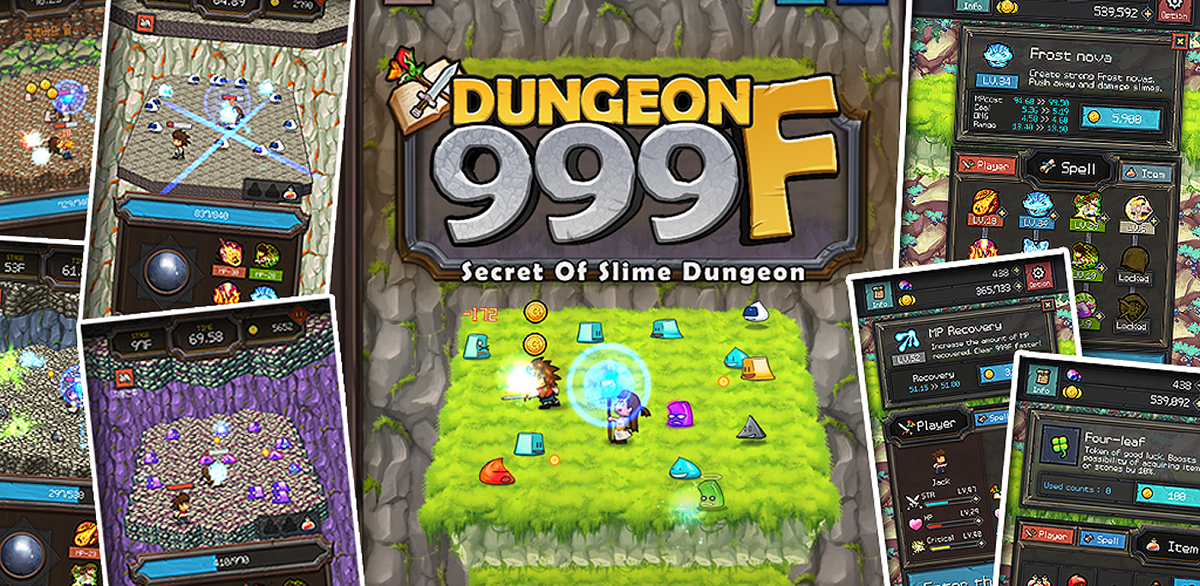
This is a making note about Dungeon999F. I made a dungeon999F as oneman army, and I hope this could be helpful to all prospective One man armys.
Game introduction : https://www.behance.net/gallery/26236031/Dungeon999F?
At first I tried to write something like a journal to show you the chronological sequence of developing the game, but at the point where the game is already completed, I had a dim recollection of the process and thus was afraid of romanticizing the past based on faint memory. So I decided to write down the keywords that came to my mind. Then it became much conveneint for others to read. I hope this could be helpful to all prospective One man armys. So let us start now!
1. Secure graphic resources.
Perhaps this is because I was a designer originally, but when I first start brainstorming ideas for a new game, I like to decide the overall atmosphere of the game more than waiting for an innovative idea. Another reason for this is because the mass production of graphic resources is very difficult, as I'm a single developer :( Unlike when you are working with teammates with different roles, graphic resources are very important materials in the developing process itself to a single developer, not only in game. I believe that one person can make enough resources alone if the tone and making process of the game are precisely decided at the beginning. There are many ways to make these - for instance you could use a pixel art or 3D modeling- but I don't recommend a certain one over another. It's important to to find what fits the developer the best. In my case I can do 3D modeling and post-production, so I always use these two techniques to make resources. Now I'll explain the process one by one.
- Character
Things may differ depending on each game, but in most cases I believe that making character resources is the most important part.
Fortunately I had made some characters before starting this project. They were made in very ambiguous tone, not pixel nor 3D images, and thus were left behind in the Work folder for a long time.But the process structure I had composed for those was very fast(almost 1 character a day), so I decided to adopt the same process in this project too.When I make a character like this one, I go through these procedures.
Sketch -> Modeling -> Rendering -> Pixelate -> Individual revisions and effect addition -> Sprite
Let's start with sketching...
You might say 'are you kidding?!' but it's true... I'm not very good at drawing...
One of the reasons I work on 3D is because of my drawing.
Anyway, I draw the bluesketch in my head and then proceed on modeling. After modeling I plant the joints and design animations at the same time. The strong point of 3D work is that you can reuse the animation you've made before. Of course making new animation according to every charcter to emphasize different characteristics would be desirable, but considering that I'm developing all these myself, it's not a bad choice to find a moderate alternative..(Maybe I'm just self-justifying..)


After the modeling and animation work are done, I move on to rendering process.
The final resource would look like 2D anyway, so I didn't work so hard on it. It's extremely important to label the animation parts by naming to organize them easily later, or you might get confused on which part was the one you wanted.
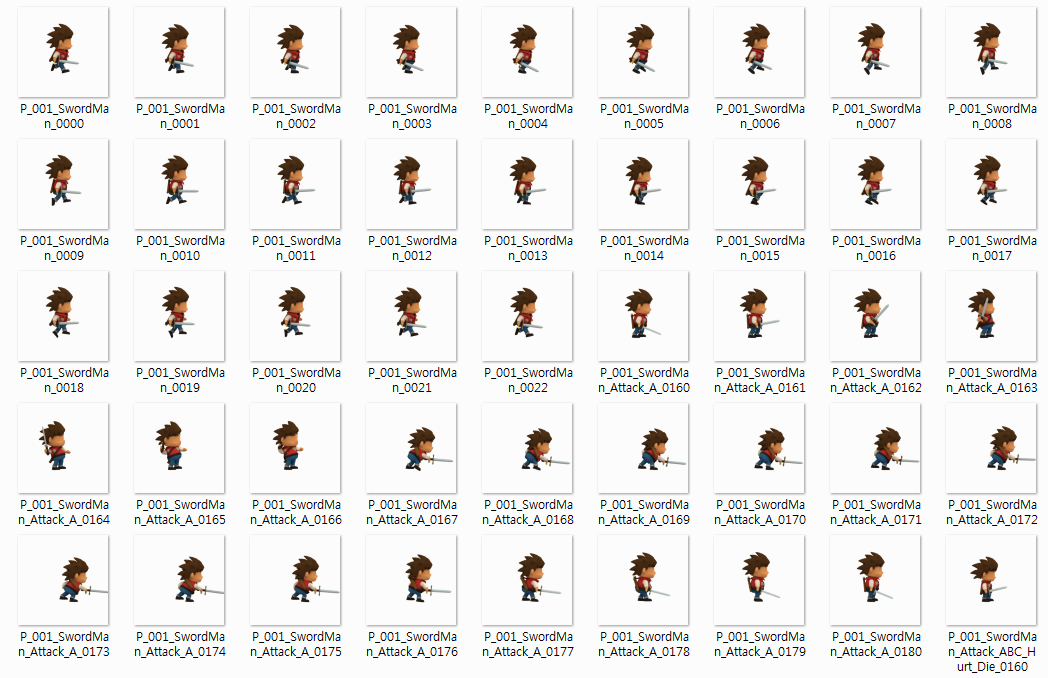
Use a tool like After Effect to draw the outline and face on the rendered resource, and it's done!

Previously I had processed the face in 3D program, but in this project I tried framing the facial expression one by one. It takes twice as long, but you can describe the face in a more cartoon-like expression this way.
Now that the main characters are done, I should make slimes, another important character of the game. I started by sketching it...

Yes... when I have the bluesketch in my head, the outcome on paper tend to be a bit messy...
Now I do the modeling and animation work just like I did for the main characters,

render this, open it in After Effect to draw the face, outline and apply effect separately

I've never been a professional animator so the result was not that great, but it was still usable so I began to mass produce. I wrote the process quite simple here, but I have tested techniques other than this one. There's no fixed answer to the question of what process one should use, so you can use another method if that fits you better. Alright. I decided to start the mass production, so I made different forms of slimes from the prototype, applied the same animation, and rendered the resource.
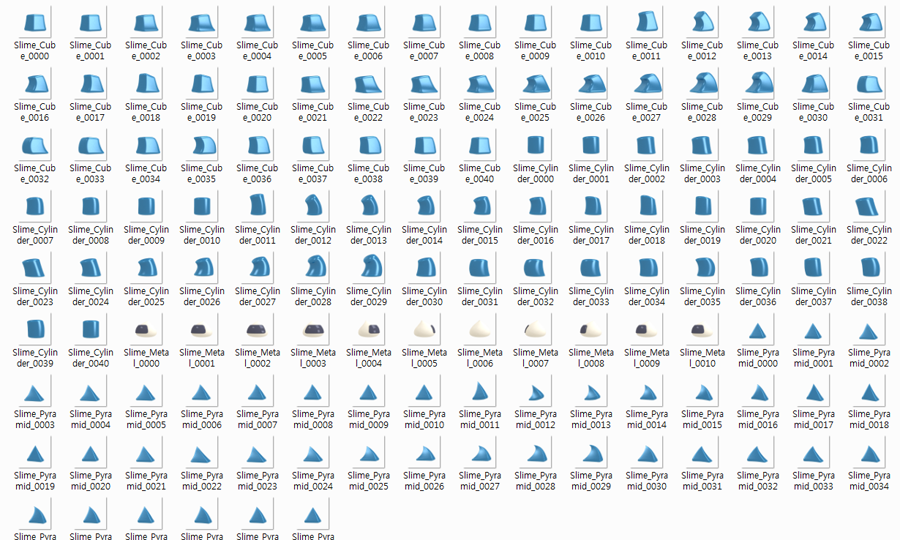
They look very similar don't they...
I changed the resource from the previous work, switched the color and relocated the face to generate various slimes. I say it's 'various', but the process was mostly 'copy and paste'. In fact the reason why only slimes emerge in the game is because I wanted to reduce the resource I had to work on.
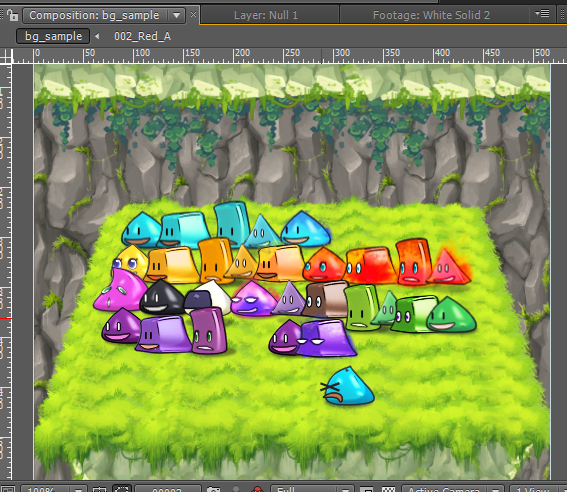
- Background Resource
Since I usually like making characters and they are essential part of the game, I didn't have much trouble completing the characters. But in the case with background resources(plus when I'm developing this alone), was a different story. To maintain the overall tone of the game, making it myself would have been the best choice, but thanks to my occupation which I get to look around many graphic resources in Unity's 'Asset Store', I was recommended this fine map editor!!

Later I found out that it actually was a great program.
There were amusing functions like pen tool from Photoshop or automatic impinging region generator, but for a relatively simple game like Dungeon 999F, this editor was too much and didn't feel very suitable. What I needed for Dungeon 999F was actually a simple terrain texture, not the map editing function. So I just adopted the texture in the program and produced another type of map.
If you are planning to use external resources like me, I would recommend you to edit the part you need for the game because that's much effective in terms of capacity and efficiency.

-Item
At first I planned to use external resources for the items because there were tons of well-made resources already, but then it came to me that using too much of external resources could spoil the overall tone of the game. So decided to make some basic items myself.
Sure, this could be a waste of time considering that it's a single-developing project, but I tried it just as a practice. I started by sketching. Since I didn't want to do the modeling with the items, I sketched them in more detailed manners.

After the sketch is done, all you have to do is draw the image using a graphic tool like Photoshop.
There are largely two methods in making an image of this kind. First you can use a tablet pen(or just mouse is fine) to shadow the line. Second, you can use Pentool to fill the color in a certain area. This way you would have your result as a vector image.
Personally, I consider whether the resource is recyclable very important, so I choose the second method to make the image(The truth is... I'm not good at using the brush). Producing a vector image is more hard labor than drawing, but there's an advantage that you can have an image of similar state by changing the figures slightly even when you increase the size. You don't know when you'll have to make another image when you're developing a game alone, so I judged that it would be better to make reusable resources, whatever they are.

Items were made with vector images, but since the skill icons were made by reducing the size of a picture, I couldn't help but shadow it myself. These initially strange icons become very miserable when they are zoomed-in, thanks to my drawing skill.... If you have ten thumbs like me, I recommend you to use vector images.... : (

There are lot more to tell about the graphic resources, but then this post will get too long... Like I said above, there's no fixed answer, so the best way is to find what the method that fits you.
But to emphasize one thing, the method with which you can make as many images as possible in a limited amount of time would be desirable. In other words, I believe that efficiency is the first priority in producing a graphic resource to a oneman army.
2. An efficient tool to substitute manpower.
What is as important as making the graphic resource, is to choose an efficient tool. As I'm not a team in which roles are specialized for each members, I have to do everything myself....
So it is wise to choose an efficient program that can substitute manpower. Even if you are developing the game alone, that doens't mean you are free from organizing tons of graphic, data, schedules, and documents.
Here, I introduce you the tool I felt the most productive.
-Unity
In the old days, many created a native code or engine themselves, but nowadays when game developing engines are becoming dramatically inexpensive, it seems universal to use one of such programs.Besides most of them are free to indie game developers...!! (Feels like an urgently promoting unity...)
Anyway, I chose Unity for the developing engine. Because Unity itself has the most suitable interface for an individual like me to work on. It allows development on component basis which facilitates the reuse of existing code, a perfect function for busy solo-developers. Plus there are tons of plug-ins adequate to most kinds of mobile platforms(e.g. facebook SDK or various advertisment modules) provided, which save great time for creating complicated native codes. Sometimes I feel as if I'm outsourcing this task to plug-in producers...

- Google Drive
One thing one could easily neglect when developing a game alone is the organization of data. You might think this is not so important for a simple game like this one, but all games inevitably have a certain amount of numerical values involved. Before I didn't care about this very much, but as the game got near to its completion, such impromptu decision on characters' stats eventually caused the overall balance to collapse...Using Excel is fine, but I think Google Spreadsheet is better since it allows you to work when you're moving or outside. It provides a more effcient environment for organizing data.
Recently a tool interworking the Google drive and the stats of characters in the game was released, but I don't really recommend it due to the concern of safety and security.
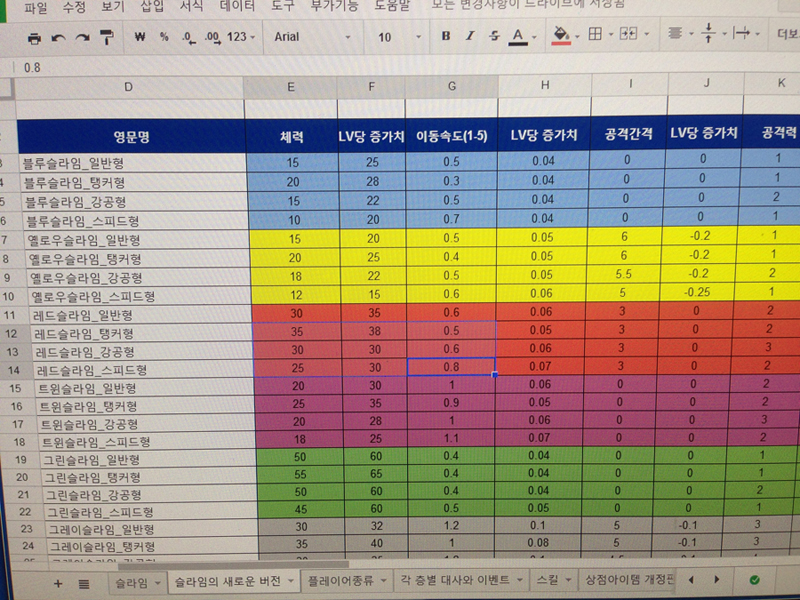
-Trello
Originally this tool is more famous for organizing schedules based on tasks in a cooperation work. But if you are extremely diligent and a master of self-regulation, I guess you won't need it that much... When developing things alone, not in a time, it sometimes makes me think writing the task town on its own can seem like a waste of time.
Of course, I'm not a very diligent person, so I used Trello quite suitably. Especially when you are developing the game and at the same time working for a corporation, the rhythms of two different roles often get jumbled and messy, bringing this question to the mind: 'what am I doing right now!' Well, if you use Trello, you can organize how much you've done and how long you should work on more in a neat way, and this gives you a certain satisfaction with a will to administer oneself. Once again, note that if you are already good at controlling your own schedules, this can be just a waste of time..I wish I could be one of those people..

3. Test various prototypes
This is the biggest lesson I learned in this project.
I used to think that I created the prototypes in many diverse ways as I could, but in fact I tended to stick to the first prototype I made for I felt somewhat sorry to abandon it. This may not be only me, because when you're working alone, there's no one to apply a break on your thoughts, which easily lead to an arrogant idea that 'this must be fun to others, because it's fun to me!.' (...or is it just me again..)
As a matter of fact, I first started this project based on my first prototype, but then I got feedbacks from others after 2 months that it sucked. Thus I had to start it all over again based on another prototype...
I recommend you to try various types, not just the first one. I believe it's better to try out different ones, choose the best type, and work on it, than just to stick to a single one and complete it only to fail. (Well I can't prove it because I haven't done it myself yet... haha) Anyway the initial plan of Dungeon 999F was very different than what it is today. It was something like this. You see even the proportion of the main characters was very strange...

You could jump by tapping the screen. Depending on the duration of touch, the types of jump would vary. It was a very simple game....And interestingly it gradually grew more and more boring even to me...
First I thought it was the problem of the interface so I improved the UI. Then I tried making a mini-battle at the lobby with simple taps...
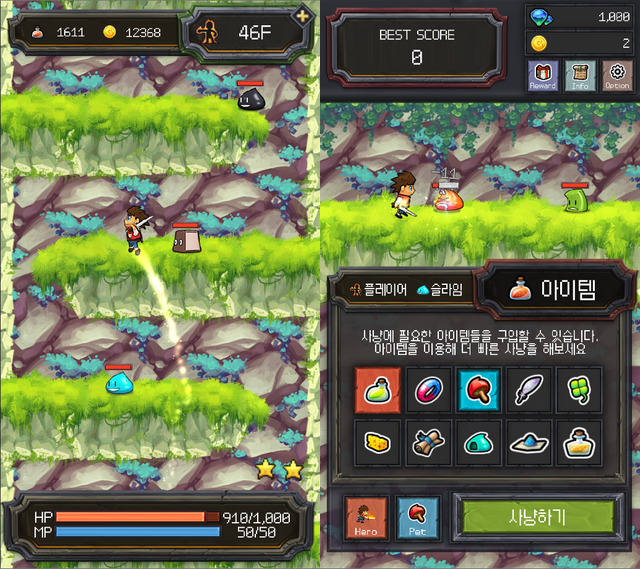
But as time passed, it seemed that the fundamental method of the game should change to improve the situation. Some acquaintances suggested me to try some more on this initial plan, but since it was a very delicate issue, I decided that making a new prototype would take less time than to look for a way to spare this one.
I came up with several ideas, the main one was about controlling two characters at once like the previous game, Wedding Run.

I even tried something rather excessive like adopting a dualstick into the game.
Basically you had to control two characters individually with two joysticks...
Through these ups and downs, the game structure as it is now finally came in to shape.
One of the feedbacks I got many times, were demands for a female character!! Everyone who played the game wanted the magician to be a girl, so the unfortunate male magician was substituted by a female named Rose.
She is not that pretty at all, but reflecting the feedbacks she got after the game was relased, I wonder what would have happened if the magician was a male character :p

4. Autopilot and balance test.
One of the agonies a One man army has to suffer is the task of designing levels and balances.
Those who have experinece of dveloping a game would know that one tends to avoid playing the game he or she has made... because one is too fed up with it.However, to adjust the balance of 999 stages, I had to simulate the game myself because I couldn't ensure the numerical values could prove everything.This was why I made the autopilot system. I never planned to make one, but during a test I realized that it was extremely convenient. So I just adopted the system.I didn't have enough time to clear every stage personally, so with the autopilot and codes to change the characters' stats to a suitable level, I ran a quick simulation. Then I set the balance by fixing the clear time of each stage within a certain time range.

In the console window at the top, you can see the debugging codes.
I designed it to clear the stage with 20 sec to spare, and the characters to change to a proper level. The autopilot system helped a lot in calculating which level is the most adequate for each stage, by making the character rerun the test with different level if the clear time is too short or long. But it was better to set the balance manually after these automatic procedures to make the game more interesting. Especially in the very beginning, it's essential to set the level of difficulty at its lowest.
5. Other things to prepare for
In fact, developing is not the only big part of releasing the game. You have to make an image and a video for the market, write an introduction, or make a material for promotion like what I'm doing right now. This phase of releasing the game should never be overlooked, or you might get exhausted after completing the development. This is also my weak point, which leads to wrapping things up rather carelessly... To prevent such exhaution, it will be helpful to note that a One man army have to prepare following things for registering the game on the market and promotion.

- Securing some big-sized screenshots.
This sounds quite easy, but in case of Appstore where you can upload only 5 images, deciding which pictures to register becomes a very serious concern. Besides for games like Dungeon 999F which becomes a total mess soon as you start to play, it's hard to capture a nice screenshot. So it's important to collect screenshots from time to time when you see a nice picture.
- Collecting playing clips for video making
This, too, is harder than it sounds. I wouldn't have to explain the necessity of video-making in these days.
To give you a tip, I recommend you to turn of the game's BGM when recording the playing clips, or the sounds might get all mixed up when you edit them afterwards.
- Writing intoductions to upload on the market.
I am really bad at writing. The first draft of every writing goes straight into the waste bin.
These tips I'm writing now are what I've revised for hundreds times, but I have a strong feeling that I would want to revise it again later. I don't think it's only me, so I believe it is better to refine the introduction for the market for several times throughout a few days, rather than just writing roughly pressed for time.
- Involvement in online community
This one refers to what I'm doing right now, posting a writing that looks like an advertisement.
Some might think 'So what. You're just another salesman', but I believe it important to introduce the game to others by any means. In the market where hundreds of games are released everyday, not advertising the game might make it to be forgotten, with only about 50 downloaders who are mostly acquaintances. (This is my own story...)
Wow, feels like i've been blabbing for a long time! But it's been a while since i've launched a game that feels like a real game to me. So please take it as a congratutory speech to me. To end the long speech, here is the office that made all of this possible, my magic layer, the computer room of my house!

So this is it!
It was a very long post reflecting the time I spent to develop... Since it's a paid application, I don't urge you to download it, but I just wanted to introduce the process it took to complete the game! Still, to those who thought that the game sounded interesting after reading all the efforts I've put into it, I should be very grateful if you might download the game : )
You'll see it if you type 'Dungeon 999' in the search box, but I'll leave the link just in case.
+ Appstore(iOS) - Free
https://itunes.apple.com/app/dungeon-999f/id969388298
https://itunes.apple.com/us/app/dungeon999f-free/id1018144526 - Free
+ GooglePlay (Android)
https://play.google.com/store/apps/details?id=com.moontm.Dungeon999F
https://play.google.com/store/apps/details?id=com.moontm.Dungeon999Ffree - Free
Thank you for reading!
ps. All the daily records about developing, though in Korean, are steadily uploaded on my blog and Facebook, so anyone who's interested in life of a' One man army and at the same time a businessman', please visit some time!
blog(Korean) : http://www.jiguk.co.kr
facebook : https://www.facebook.com/gukhwan.ji
Read more about:
Featured BlogsAbout the Author(s)
You May Also Like









